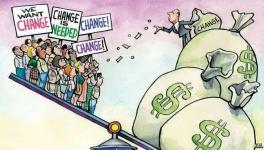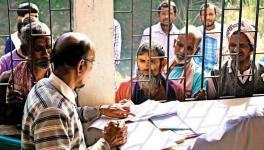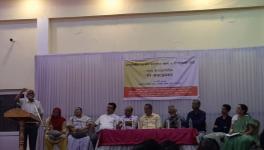The Great ‘Aadhaar-is-Saving-Billions” Hoax

Image Courtesy: rightlog.in
Speaking in Washington on 12 October, Nandan Nilekani , the man behind Aadhar, said that “It has also saved the government about $9 billion in fraud and wastage because by having that unique number you eliminate fakes and duplicates from your beneficiary and employee list.”
This and a similar statements repeated endlessly by many supporters of the Modi government that Aadhar had saved $11 billion, have acquired a Goebbelsian traction, swallowed by mainstream media unquestioningly . IT minister R.S. Prasad claimed the same thing on September 8, 2016, the CEO of Aadhar authority (UIDAI) AB Pandey repeated it on May 13, 2017. By that time, the government had begun to really believe it and so it asserted the same $11-billion figure in an affidavit filed before the Supreme Court on April 27, 2017 during the right to privacy hearings.
The truth is far from this.
As has been shown by food rights activist from IIT Delhi Reetika Khera the figure of $11 billion was popularised by the World Bank in its 2016 World Development Report. What is their source of information?
They lifted the figure from a Washington based think tank called Consultative Group to Assist the Poor (CGAP) housed at the World Bank itself. But in doing so, the mandarins of World Bank made a fatal slip. The CGAP study clearly says that the “value of transfers” is Rs.70,000 crore ($11.3 billion) per annum. They are talking about all the money that is directly being transferred to beneficiaries in schemes like MGNREGA, NSAP, JSY, LPG subsidy and scholarships for SC/ST.
The government converted “value of transfers” to “potential savings”. The rest is history.
Let’s take a charitable view and assume that some savings have taken place. How much? There is no firm data but several estimates are periodically floated only to perish under the microscope.
As TheWire has pointed out claims on savings made by shifting LPG subsidy to direct cash transfers have been debuked by the CAG, the International Institute for Sustainable Development and various analyses published in the EPW. In fact the govt. has said in Parliament that fall in LPG subsidies were due to various factors including dipping crude oil prices, the GiveItUp campaign, etc.
The World Bank has said that it extrapolated from other studies to “estimate” that 11-14% savings took place on the govt.’s total expenditure on welfare programmes, which was $70-100 billion. It calls this estimate “potential” savings.
But by the time it takes off from Washington and lands in New Delhi, all caveats are blown away, as are dodgy assumptions. The Modi government, innocent of data and evidence, takes it as gospel. And so do its camp followers.
Disclaimer: The views expressed here are the author's personal views, and do not necessarily represent the views of Newsclick.
Get the latest reports & analysis with people's perspective on Protests, movements & deep analytical videos, discussions of the current affairs in your Telegram app. Subscribe to NewsClick's Telegram channel & get Real-Time updates on stories, as they get published on our website.
























